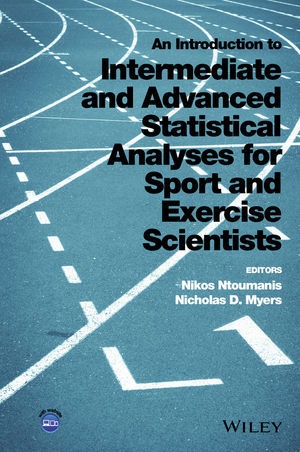Read more
Ntoumanis and Myers have done sport and exercise science researchers and students a tremendous service in producing An Introduction to Intermediate and Advanced Statistical Analyses for Sport and Exercise Scientists. This book has an outstanding compilation of comprehensible chapters dealing with the important concepts and technical minutia of the statistical analyses that sport and exercise science scholars use (or should be using!) in their efforts to conduct meaningful research in the field. It is a resource that all sport and exercise scientists and their students should have on their book shelves. Robert Eklund, School of Sport, University of Stirling, UK
Motivating, to have a statistics text devoted to enabling researchers studying sport and exercise science to apply the most sophisticated analytical techniques to their data. Authors hit the mark between using technical language as necessary and user-friendly terms or translations to keep users encouraged. Text covers traditional and well-used tools but also less common and more complex tools, but always with familiar examples to make their explanations come alive. As a dynamic systems theorist and developmentalist, I would love to see more researchers in my area create study designs that would enable the use of tools outlined here, such as multilevel structural equation modeling (MSEM) or mediation & moderation analyses, to uncover cascades of relations among subsystems contributing to motor performance, over time. This text can facilitate that outcome. Beverly D. Ulrich, School of Kinesiology, University of Michigan, USA
The domain of quantitative methods is constantly evolving and expanding. This means that there is tremendous pressure on researchers to stay current, both in terms of best practices and improvements in more traditional methods as well as increasingly complex new methods. With this volume Ntoumanis and Myers present a nice cross-section of both, helping sport and exercise science researchers to address old questions in better ways, and, even more excitingly, to address new questions entirely. I have no doubt that this volume will quickly become a lovingly dog-eared companion for students and researchers, helping them to continue to move the field forward. Gregory R. Hancock, University of Maryland and Center for Integrated Latent Variable Research (CILVR), USA
List of contents
About the editors xiii
List of contributors xv
Foreword xix
Preface xxi
1 Factorial ANOVA and MANOVA 1
General Introduction 1
Hypothesis Testing 2
Alpha Level 2
Assumptions 3
Further Considerations 4
Utility in Sport and Exercise Sciences 6
Treatment Conditions 6
Existing Conditions 6
Individual Characteristics 7
Recent Usage 7
The Substantive Example 7
Univariate: Factorial ANOVA 8
Univariate Assumptions 8
The Synergy 10
Factorial ANOVA Analysis Plan 10
Example of a Write?]Up Compatible with the APA Publication Manual 11
Factorial MANOVA Analysis Plan 13
Example of a Write?]Up Compatible with the APA Publication Manual 13
Summary 16
Acknowledgment 18
References 18
2 Repeated measures ANOVA and MANOVA 19
General Introduction 19
Between?] versus Within?]Subjects Variables 19
Hypothesis Testing 20
Assumptions 20
Further Considerations 21
Utility in Sport and Exercise Sciences 22
Multiple Treatment Conditions 23
Multiple Assessments 23
Longitudinal Studies 23
Recent Usage 24
The Substantive Example 24
Univariate: Repeated Measures ANOVA 24
Univariate Assumptions 25
Multivariate: Repeated Measures MANOVA 26
Multivariate Assumptions 26
The Synergy 27
Repeated Measures ANOVA Analysis Plan 27
Example of a Write?]Up Compatible with the APA Publication Manual 29
Repeated Measures MANOVA Analysis Plan 29
Example of a Write?]Up Compatible with the APA Publication Manual 31
Summary 32
Acknowledgment 34
References 34
3 Mediation and moderation via regression analysis 35
General Introduction 35
Utility of the Methods in Sport and Exercise Science 36
The Substantive Example 38
Mediation 38
The Synergy 38
Mediation 38
The Substantive Example 44
Moderation 44
The Synergy 45
Moderation 45
Summary 53
References 55
4 Item response theory and its applications in Kinesiology 57
General Introduction 57
What Is IRT? 59
Other Commonly Used IRT Models 60
Assumptions Related to IRT 62
Unidimensionality 62
Local Independence 62
Addressing Model?]Data Fit 62
Inspecting Model Assumptions 63
Inspecting Expected Model Features 63
Inspecting Overall Model?]Data Fit 64
Computer Simulation for Model?]Data Fit Testing 64
Unique Features and Advantages of IRT 65
Estimation Invariance 65
Common Metric Scale 65
Item and Test Information 66
Test Relative Efficiency 68
Global "Reliability" Is no Longer a Concern 69
Item Bank and IRT?]Based Test Construction 69
Parameter Estimation and Software 71
Utility of the Methodology in Kinesiology 71
IRT Limitations and Future Direction 72
Conclusion 73
References 74
5 Introduction to factor analysis and structural equation modeling 79
General Introduction 79
Utility of the Method in Sport and Exercise Science 80
Terminology and Methodology 83
Evaluating Model Fit 86
Interpreting Parameter Estimates 88
The Substantive Example 89
About the author
Nikos Ntoumanis, School of Sport, Exercise and Rehabilitation Sciences, University of Birmingham, Birmingham, UK. Nikos has been teaching statistics to sport and exercise sciences university students for 14 years in two UK universities and delivered statistics workshops in the UK and overseas.
Nicholas Daniel Myers, Department of Educational and Psychological Studies, University of Miami, Florida, USA. His expertise is in advanced statistical methods with an emphasis on applications in sport and exercise science. Nicholas serves as Director of the Research, Measurement, and Evaluation (RME) doctoral program at the University of Miami. The RME doctoral program has been rated a top-20 program nationally by Academic Analytics since 2006 and has served as a statistical consultant for the Research Methodology Services component of the Dunspaugh-Dalton Community and Educational Well-Being (CEW) Research Centre at the University of Miami.
Summary
Ntoumanis and Myers have done sport and exercise science researchers and students a tremendous service in producing An Introduction to Intermediate and Advanced Statistical Analyses for Sport and Exercise Scientists.

